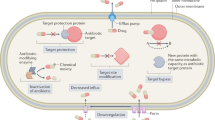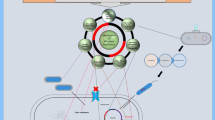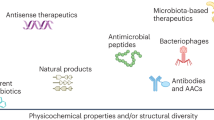Key Points
-
The antibiotic resistome is the collection of all the antibiotic resistance genes, including those usually associated with pathogenic bacteria isolated in the clinics, non-pathogenic antibiotic producing bacteria and all other resistance genes.
-
Many bacterial genomes contain cryptic resistance genes that can confer resistance, but do not seem to have been selected in response to recent exposure to antibiotics. These represent a large reservoir of antibiotic resistance genes.
-
The antibiotic resistance genes in environmental and other non-pathogenic bacteria share amino-acid sequence similarities and biochemical mechanisms with resistance elements in clinical isolates.
-
Structural biology and protein biochemistry has revealed that antibiotic resistance has evolved from precursor proteins with other metabolic functions. The powerful selection pressure produced by the use of cytotoxic antimicrobial agents spurs the selection of resistance mechanisms from these precursors.
-
Antibiotics are ancient, dating back hundreds of millions of years. Resistance is therefore equally ancient, and the number of genes in the resistome is a reflection of the continuous co-evolution of small molecules in natural environments and microbial genomes.
Abstract
Over the millennia, microorganisms have evolved evasion strategies to overcome a myriad of chemical and environmental challenges, including antimicrobial drugs. Even before the first clinical use of antibiotics more than 60 years ago, resistant organisms had been isolated. Moreover, the potential problem of the widespread distribution of antibiotic resistant bacteria was recognized by scientists and healthcare specialists from the initial use of these drugs. Why is resistance inevitable and where does it come from? Understanding the molecular diversity that underlies resistance will inform our use of these drugs and guide efforts to develop new efficacious antibiotics.
This is a preview of subscription content, access via your institution
Access options
Subscribe to this journal
Receive 12 print issues and online access
$209.00 per year
only $17.42 per issue
Buy this article
- Purchase on SpringerLink
- Instant access to full article PDF
Prices may be subject to local taxes which are calculated during checkout






Similar content being viewed by others
References
Winau, F., Westphal, O. & Winau, R. Paul Ehrlich — in search of the magic bullet. Microbes Infect. 6, 786–789 (2004).
Overbye, K. M. & Barrett, J. F. Antibiotics: where did we go wrong? Drug Discov. Today 10, 45–52 (2005).
Projan, S. J. Why is big Pharma getting out of antibacterial drug discovery? Curr. Opin. Microbiol. 6, 427–430 (2003). An excellent discussion of the challenges of modern antimicrobial drug discovery.
Projan, S. J. & Shlaes, D. M. Antibacterial drug discovery: is it all downhill from here? Clin. Microbiol. Infect. 10 (Suppl. 4), 18–22 (2004).
Tenover, F. C. Mechanisms of antimicrobial resistance in bacteria. Am. J. Med. 119, S3–S10; discussion S62–S70 (2006).
McGowan, J. E. Jr . Resistance in nonfermenting Gram-negative bacteria: multidrug resistance to the maximum. Am. J. Infect. Control 34, S29–S37; discussion S64–S73 (2006).
Giamarellos-Bourboulis, E. J. et al. Clarithromycin is an effective immunomodulator in experimental pyelonephritis caused by pan-resistant Klebsiella pneumoniae. J. Antimicrob. Chemother. 57, 937–944 (2006).
Levy, S. B. & Marshall, B. Antibacterial resistance worldwide: causes, challenges and responses. Nature Med. 10, S122–S129 (2004).
Livermore, D. M. The need for new antibiotics. Clin. Microbiol. Infect. 10 (Suppl. 4), 1–9 (2004).
Alekshun, M. N. & Levy, S. B. Commensals upon us. Biochem. Pharmacol. 71, 893–900 (2006).
Rice, L. B. Unmet medical needs in antibacterial therapy. Biochem. Pharmacol. 71, 991–995 (2006).
Robinson, D. A. et al. Re-emergence of early pandemic Staphylococcus aureus as a community-acquired methicillin-resistant clone. Lancet 365, 1256–1258 (2005).
File, T. M. Jr . Clinical implications and treatment of multiresistant Streptococcus pneumoniae pneumonia. Clin. Microbiol. Infect. 12 (Suppl. 3), 31–41 (2006).
Nguyen, L. & Thompson, C. J. Foundations of antibiotic resistance in bacterial physiology: the mycobacterial paradigm. Trends Microbiol. 14, 304–312 (2006).
Riley, M. et al. Escherichia coli K-12: a cooperatively developed annotation snapshot — 2005. Nucleic Acids Res. 34, 1–9 (2006).
Yu, E. W., McDermott, G., Zgurskaya, H. I., Nikaido, H. & Koshland, D. E. Jr . Structural basis of multiple drug-binding capacity of the AcrB multidrug efflux pump. Science 300, 976–980 (2003).
Hillen, W. & Berens, C. Mechanisms underlying expression of Tn10 encoded tetracycline resistance. Annu. Rev. Microbiol. 48, 345–369 (1994).
Ramos, J. L. et al. The TetR family of transcriptional repressors. Microbiol. Mol. Biol. Rev. 69, 326–356 (2005).
Alekshun, M. N. & Levy, S. B. The mar regulon: multiple resistance to antibiotics and other toxic chemicals. Trends Microbiol. 7, 410–413 (1999).
Tsui, W. H. et al. Dual effects of MLS antibiotics: transcriptional modulation and interactions on the ribosome. Chem. Biol. 11, 1307–1316 (2004).
Goh, E. B. et al. Transcriptional modulation of bacterial gene expression by subinhibitory concentrations of antibiotics. Proc. Natl Acad. Sci. USA 99, 17025–17030 (2002).
Wright, G. D. Bacterial resistance to antibiotics: enzymatic degradation and modification. Adv. Drug Deliv. Rev. 57, 1451–1470 (2005).
Pootoolal, J., Neu, J. & Wright, G. D. Glycopeptide antibiotic resistance. Annu. Rev. Pharmacol. Toxicol. 42, 381–408 (2002).
Walsh, C. T., Fisher, S. L., Park, I.-S., Prohalad, M. & Wu, Z. Bacterial resistance to vancomycin: five genes and one missing hydrogen bond tell the story. Chem. Biol. 3, 21–28 (1996).
Wilson, P. et al. Linezolid resistance in clinical isolates of Staphylococcus aureus. J. Antimicrob. Chemother. 51, 186–188 (2003).
Poole, K. Aminoglycoside resistance in Pseudomonas aeruginosa. Antimicrob. Agents Chemother. 49, 479–487 (2005).
D'Costa, V. M., McGrann, K. M., Hughes, D. W. & Wright, G. D. Sampling the antibiotic resistome. Science 311, 374–377 (2006). This manuscript describes a systematic study of the level of antibiotic resistance in a population of environmental bacteria that demonstrates that multidrug resistance is much more prevalent than previously thought.
Piddock, L. J. Clinically relevant chromosomally encoded multidrug resistance efflux pumps in bacteria. Clin. Microbiol. Rev. 19, 382–402 (2006).
Poole, K. & Srikumar, R. Multidrug efflux in Pseudomonas aeruginosa: components, mechanisms and clinical significance. Curr. Top Med. Chem. 1, 59–71 (2001).
Stover, C. K. et al. Complete genome sequence of Pseudomonas aeruginosa PA01, an opportunistic pathogen. Nature 406, 959–964 (2000).
Piddock, L. J. Multidrug-resistance efflux pumps — not just for resistance. Nature Rev. Microbiol. 4, 629–636 (2006).
Fisher, J. F., Meroueh, S. O. & Mobashery, S. Bacterial resistance to β-lactam antibiotics: compelling opportunism, compelling opportunity. Chem. Rev. 105, 395–424 (2005).
Sugantino, M. & Roderick, S. L. Crystal structure of Vat(D): an acetyltransferase that inactivates streptogramin group A antibiotics. Biochemistry 41, 2209–2216 (2002).
Seoane, A. & Garcia Lobo, J. M. Identification of a streptogramin A acetyltransferase gene in the chromosome of Yersinia enterocolitica. Antimicrob. Agents Chemother. 44, 905–909 (2000). A study that shows that type A streptogramin acetyltransferases are widely distributed in bacterial genomes.
Mukhtar, T. A., Koteva, K. P., Hughes, D. W. & Wright, G. D. Vgb from Staphylococcus aureus inactivates streptogramin B antibiotics by an elimination mechanism not hydrolysis. Biochemistry 40, 8877–8886 (2001).
Canton, R. & Coque, T. M. The CTX-M b-lactamase pandemic. Curr. Opin. Microbiol. 9, 466–475 (2006).
Humeniuk, C. et al. β-Lactamases of Kluyvera ascorbata, probable progenitors of some plasmid-encoded CTX-M types. Antimicrob. Agents Chemother. 46, 3045–3049 (2002).
Poirel, L., Kampfer, P. & Nordmann, P. Chromosome-encoded Ambler class A β-lactamase of Kluyvera georgiana, a probable progenitor of a subgroup of CTX-M extended-spectrum β-lactamases. Antimicrob. Agents Chemother. 46, 4038–4040 (2002).
Decousser, J. W., Poirel, L. & Nordmann, P. Characterization of a chromosomally encoded extended-spectrum class A β-lactamase from Kluyvera cryocrescens. Antimicrob. Agents Chemother. 45, 3595–3598 (2001).
Lartigue, M. F., Poirel, L., Aubert, D. & Nordmann, P. In vitro analysis of ISEcp1B-mediated mobilization of naturally occurring β-lactamase gene blaCTX-M of Kluyvera ascorbata. Antimicrob. Agents Chemother. 50, 1282–1286 (2006).
Wright, G. D., Berghuis, A. M. & Mobashery, S. Aminoglycoside antibiotics. Structures, functions, and resistance. Adv. Exp. Med. Biol. 456, 27–69 (1998).
Hachler, H., Santarnam, P. & Kayser, F. H. Sequence and characterization of a novel chromosomal aminoglycoside phosphotransferase gene aph(3')-IIb in Pseudomonas aeruginosa. Antimicrob. Agents Chemother. 40, 1254–1256 (1996).
Thompson, P. R., Hughes, D. W., Cianciotto, N. P. & Wright, G. D. Spectinomycin kinase from Legionella pneumophila, Characterization of substrate specificity and identification of catalytically important residues. J. Biol. Chem. 273, 14788–14795 (1998).
Draker, K. A., Boehr, D. D., Elowe, N. H., Noga, T. J. & Wright, G. D. Functional annotation of putative aminoglycoside antibiotic modifying proteins in Mycobacterium tuberculosis H37Rv. J. Antibiot. (Tokyo) 56, 135–142 (2003).
Poirel, L., Decousser, J. W. & Nordmann, P. Insertion sequence ISEcp1B is involved in expression and mobilization of a bla(CTX-M) β-lactamase gene. Antimicrob. Agents Chemother. 47, 2938–2945 (2003).
Toleman, M. A., Bennett, P. M. & Walsh, T. R. ISCR elements: novel gene-capturing systems of the 21st century? Microbiol. Mol. Biol. Rev. 70, 296–316 (2006).
Hall, R. M. & Collis, C. M. Antibiotic resistance in Gram-negative bacteria: the role of gene cassettes and integrons. Drug Resist. Updat. 1, 109–119 (1998).
Finan, T. M. et al. The complete sequence of the 1,683-kb pSymB megaplasmid from the N2-fixing endosymbiont Sinorhizobium meliloti. Proc. Natl Acad. Sci. USA 98, 9889–9894 (2001).
Gilmour, M. W., Thomson, N. R., Sanders, M., Parkhill, J. & Taylor, D. E. The complete nucleotide sequence of the resistance plasmid R478: defining the backbone components of incompatibility group H conjugative plasmids through comparative genomics. Plasmid 52, 182–202 (2004).
O'Driscoll, J., Glynn, F., Fitzgerald, G. F. & van Sinderen, D. Sequence analysis of the lactococcal plasmid pNP40: a mobile replicon for coping with environmental hazards. J. Bacteriol. 188, 6629–6639 (2006).
Baltz, R. H. Antibiotic discovery from actinomycetes: will a renaissance follow the decline and fall? SIM News 55, 186–196 (2005). An estimate of the age of antibiotic biosynthesis clusters in antibiotic-producing bacteria.
Hall, B. G. & Barlow, M. Evolution of the serine β-lactamases: past, present and future. Drug Resist. Updat. 7, 111–123 (2004).
Cundliffe, E. How antibiotic-producing organisms avoid suicide. Annu. Rev. Microbiol. 43, 207–233 (1989).
Barna, J. C. & Williams, D. H. The structure and mode of action of glycopeptide antibiotics of the vancomycin group. Annu. Rev. Microbiol. 38, 339–357 (1984).
Kirst, H. A., Thompson, D. G. & Nicas, T. I. Historical yearly usage of vancomycin. Antimicrob. Agents Chemother. 42, 1303–1304 (1998).
Leclercq, R., Derlot, E., Duval, J. & Courvalin, P. Plasmid-mediated resistance to vancomycin and teicoplanin in Enterococcus faecium. N. Engl. J. Med. 319, 157–161 (1988).
Tenover, F. C. et al. Vancomycin-resistant Staphylococcus aureus isolate from a patient in Pennsylvania. Antimicrob. Agents Chemother. 48, 275–280 (2004).
Whitener, C. J. et al. Vancomycin-resistant Staphylococcus aureus in the absence of vancomycin exposure. Clin. Infect Dis. 38, 1049–1055 (2004).
Arthur, M. et al. Mechanisms of glycopeptide resistance in enterococci. J. Infect. 32, 11–16 (1996).
Courvalin, P. Vancomycin resistance in Gram-positive cocci. Clin. Infect Dis. 42 (Suppl. 1), 25–34 (2006).
Bugg, T. D. H. et al. Molecular basis for vancomycin resistance in Enterococcus faecium BM4147: biosynthesis of a depsipeptide peptidoglycan precursor by vancomycin resistance proteins VanH and VanA. Biochemistry 30, 10408–10415 (1991).
Marshall, C. G., Broadhead, G., Leskiw, B. K. & Wright, G. D. D-ala-D-ala ligases from glycopeptide antibiotic-producing organisms are highly homologous to the enterococcal vancomycin-resistance ligases VanA and VanB. Proc. Natl Acad. Sci. USA 94, 6480–6483 (1997).
Marshall, C. G., Lessard, I. A., Park, I. & Wright, G. D. Glycopeptide antibiotic resistance genes in glycopeptide-producing organisms. Antimicrob. Agents Chemother. 42, 2215–2220 (1998). Study that shows that non-pathogenic glycopeptide antibiotic producers share the same resistance enzymes that are found in vancomycin clinical isolates.
Marshall, C. G. & Wright, G. D. The glycopeptide antibiotic producer Streptomyces toyocaensis NRRL 15009 has both D-alanyl-D-alanine and D-alanyl-D-lactate ligases. FEMS Microbiol. Lett. 157, 295–299 (1997).
Marshall, C. G. & Wright, G. D. DdlN from vancomycin-producing Amycolatopsis orientalis C329.2 is a VanA homologue with D-alanyl-D-lactate ligase activity. J. Bacteriol. 180, 5792–5795 (1998).
Marshall, C. G., Zolli, M. & Wright, G. D. Molecular mechanism of VanHst, an α-ketoacid dehydrogenase required for glycopeptide antibiotic resistance from a glycopeptide producing organism. Biochemistry 38, 8485–8491 (1999).
Hong, H. J. et al. Characterization of an inducible vancomycin resistance system in Streptomyces coelicolor reveals a novel gene (vanK) required for drug resistance. Mol. Microbiol. 52, 1107–1121 (2004).
Patel, R., Piper, K., Cockerill, F. R., Steckelberg, J. M. & Yousten, A. A. The biopesticide Paenibacillus popilliae has a vancomycin resistance gene cluster homologous to the enterococcal VanA vancomycin resistance gene cluster. Antimicrob. Agents Chemother. 44, 705–709 (2000).
Benveniste, R. & Davies, J. Aminoglycoside antibiotic-inactivating enzymes in actinomycetes similar to those present in clinical isolates of antibiotic-resistant bacteria. Proc. Natl Acad. Sci. USA 70, 2276–2280 (1973). First study to show the similarity of antibiotic resistance mechanisms in pathogenic bacteria and antibiotic producers.
Piepersberg, W. in Biotechnology of industrial antibiotics (ed. Strohl, W.) 81–163 (Marcel Dekker, New York, 1997).
Boehr, D. D., Thompson, P. R. & Wright, G. D. Molecular mechanism of aminoglycoside antibiotic kinase APH(3′)-IIIa: roles of conserved active site residues. J. Biol. Chem. 276, 23929–23936 (2001).
Daigle, D. M., McKay, G. A., Thompson, P. R. & Wright, G. D. Aminoglycoside phosphotransferases required for antibiotic resistance are also serine protein kinases. Chem. Biol. 6, 11–18 (1998).
Daigle, D. M., McKay, G. A. & Wright, G. D. Inhibition of aminoglycoside antibiotic resistance enzymes by protein kinase inhibitors. J. Biol. Chem. 272, 24755–24758 (1997).
Hon, W. C. et al. Structure of an enzyme required for aminoglycoside resistance reveals homology to eukaryotic protein kinases. Cell 89, 887–895 (1997).
Deutscher, J. & Saier, M. H. Jr. Ser/Thr/Tyr protein phosphorylation in bacteria — for long time neglected, now well established. J. Mol. Microbiol. Biotechnol. 9, 125–131 (2005).
Kennelly, P. J. & Potts, M. Fancy meeting you here! a fresh look at 'prokaryotic' protein phosphorylation. J. Bacteriol. 178, 4759–4764 (1996).
Bentley, S. D. et al. Complete genome sequence of the model actinomycete Streptomyces coelicolor A3(2). Nature 417, 141–147 (2002).
Ikeda, H. et al. Complete genome sequence and comparative analysis of the industrial microorganism Streptomyces avermitilis. Nature Biotechnol. 21, 526–531 (2003).
Vetting, M. W., Hegde, S. S., Javid-Majd, F., Blanchard, J. S. & Roderick, S. L. Aminoglycoside 2′-N-acetyltransferase from Mycobacterium tuberculosis in complex with coenzyme A and aminoglycoside substrates. Nature Struct. Biol. 9, 653–658 (2002).
Vetting, M. W., Magnet, S., Nieves, E., Roderick, S. L. & Blanchard, J. S. A bacterial acetyltransferase capable of regioselective N-acetylation of antibiotics and histones. Chem. Biol. 11, 565–573 (2004).
Wolf, E. et al. Crystal structure of a GCN5-related N-acetyltransferase: Serratia marcescens aminoglycoside 3-N-acetyltransferase. Cell 94, 439–449 (1998).
Wybenga-Groot, L., Draker, K. a., Wright, G. D. & Berghuis, A. M. Crystal structure of an aminoglycoside 6′-N-acetyltransferase:defining the GCN5-related N-acetyltransferase superfamily fold. Structure 7, 497–507 (1999).
Vetting, M. W. et al. Structure and functions of the GNAT superfamily of acetyltransferases. Arch. Biochem. Biophys. 433, 212–226 (2005).
Massova, I. & Mobashery, S. Kinship and diversification of bacterial penicillin-binding proteins and b-lactamases. Antimicrob. Agents Chemother. 42, 1–17 (1998).
Robicsek, A. et al. Fluoroquinolone-modifying enzyme: a new adaptation of a common aminoglycoside acetyltransferase. Nature Med. 12, 83–88 (2006). Remarkable description of the evolution of an aminoglycoside resistance enzyme into a form that can modify the fluoroquinolone antibiotic ciprofloxacin resulting in resistance.
Cirz, R. T. et al. Inhibition of mutation and combating the evolution of antibiotic resistance. PLoS Biol. 3, e176 (2005).
Cirz, R. T., O' Neill B, M., Hammond, J. A., Head, S. R. & Romesberg, F. E. Defining the Pseudomonas aeruginosa SOS response and its role in the global response to the antibiotic ciprofloxacin. J. Bacteriol. 188, 7101–7110 (2006).
Heinemann, J. A. How antibiotics cause antibiotic resistance. Drug Discov. Today 4, 72–79 (1999).
Morris, R. P. et al. Ancestral antibiotic resistance in Mycobacterium tuberculosis. Proc. Natl Acad. Sci. USA 102, 12200–12205 (2005).
Walsh, C. T. Polyketide and nonribosomal peptide antibiotics: modularity and versatility. Science 303, 1805–1810 (2004).
Yim, G., Wang, H. H. & Davies, J. The truth about antibiotics. Int. J. Med. Microbiol. 296, 163–170 (2006).
Riesenfeld, C. S., Goodman, R. M. & Handelsman, J. Uncultured soil bacteria are a reservoir of new antibiotic resistance genes. Environ. Microbiol. 6, 981–989 (2004). First report of antibiotic resistance genes in the soil bacterial metagenome.
Yeh, P., Tschumi, A. I. & Kishony, R. Functional classification of drugs by properties of their pairwise interactions. Nature Genet. 38, 489–494 (2006).
Andersson, D. I. The biological cost of mutational antibiotic resistance: any practical conclusions? Curr. Opin. Microbiol. 9, 461–465 (2006).
Andersson, D. I. Persistence of antibiotic resistant bacteria. Curr. Opin. Microbiol. 6, 452–456 (2003).
Handel, A., Regoes, R. R. & Antia, R. The role of compensatory mutations in the emergence of drug resistance. PLoS Comput. Biol. 2, e137 (2006).
Kim, C., Cha, J. Y., Yan, H., Vakulenko, S. B. & Mobashery, S. Hydrolysis of ATP by aminoglycoside 3′-phosphotransferases: an unexpected cost to bacteria for harboring an antibiotic resistance enzyme. J. Biol. Chem. 281, 6964–6969 (2006).
Thompson, J. D., Higgins, D. G. & Gibson, T. J. CLUSTAL W: improving the sensitivity of progressive multiple sequence alignment through sequence weighting, position-specific gap penalties and weight matrix choice. Nucleic Acids Res. 22, 4673–4680 (1994).
Perrière, G. & Gouy, M. WWW-Query: an on-line retrieval system for biological sequence banks. Biochimie 78, 364–369 (1996).
Acknowledgements
The author's research in antibiotic resistance is supported by the Canadian Institutes of Health Research, the Natural Sciences and Engineering Research Council of Canada and a Canada Research Chair in Antibiotic Biochemistry.
Author information
Authors and Affiliations
Ethics declarations
Competing interests
The author declares no competing financial interests.
Related links
Related links
DATABASES
Entrez Genome Project
Salmonella enterica serovar Typhimurium
FURTHER INFORMATION
Glossary
- Superbug
-
A bacterial pathogen that is resistant to multiple antibiotics.
- Resistome
-
A collection of all the antibiotic resistance genes and their precursors in pathogenic and non-pathogenic bacteria.
- Cryptic resistance gene
-
A resistance gene that is embedded in a bacterial chromosome, but that is not obviously associated with antibiotic resistance. Usually either not expressed, or expressed at low levels.
- R-plasmid
-
A plasmid that is present in bacterial pathogens and environmental microorganisms, and that contains one or more antibiotic resistance genes.
Rights and permissions
About this article
Cite this article
Wright, G. The antibiotic resistome: the nexus of chemical and genetic diversity. Nat Rev Microbiol 5, 175–186 (2007). https://doi.org/10.1038/nrmicro1614
Issue Date:
DOI: https://doi.org/10.1038/nrmicro1614



